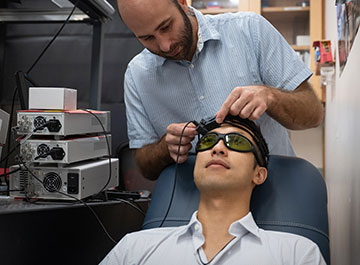
Caltech researcher Simon Mahler fits the head-mounted laser device onto graduate student Yu Xi Huang. [Image: Caltech]
Researchers in the United States have created a head-mounted laser system that they say can assess a patient's risk of future stroke by monitoring changes in blood flow and volume within the brain (Biomed. Opt. Express, doi: 10.1364/BOE.534796). The noninvasive measurement system is designed to provide physicians with a cost-effective screening tool to reduce the risk and severity of stroke, which is now one of the leading causes of death and long-term disability across the globe.
“This new method could help to catch early signs of increased stroke risk, which is key to lowering the chances of having a stroke and reducing its severity,” commented co-lead author Simon Mahler of the California Institute of Technology. “We think this can really revolutionize the way stroke risk is assessed and will eventually help doctors determine if a patient’s risk is stable or worsening.”
Speckle contrast
The wearable device, which consists only of a laser diode and a standard camera chip, exploits a technique called speckle-contrast optical spectroscopy. It works by shining infrared laser light onto the skull, and then detecting the light after it has traveled through the brain. The loss in light intensity indicates the volume of blood in the brain’s vascular system, while the rate of blood flow can be determined from the speckle patterns produced by light scattering from the blood vessels. The movement of blood causes this speckle field to fluctuate, with more rapid fluctuations indicating a faster blood flow.
To test the system, the researchers asked 50 volunteers to complete a questionnaire used by physicians to assess stroke risk, then used their scores to divide them into low-risk and high-risk groups. They measured the blood flow and volume in each volunteer for three minutes. After the first minute, the participants held their breath to force the body to pump more blood into the brain.
Although the same physiological response was observed in both groups, there was a smaller increase in the rate of blood flow when volunteers in the low-risk group held their breath, but a larger increase in the volume of blood within the brain.
Assessing stroke risk
Although the same physiological response was observed in both groups, there was a smaller increase in the rate of blood flow when volunteers in the low-risk group held their breath, but a larger increase in the volume of blood within the brain. This indicates that the blood vessels had widened to hold more blood. In people at high risk of stroke, however, the blood vessels are less able to expand and the blood must flow more quickly to deliver enough oxygen to the brain.
“We can clearly see that the higher-risk group has a higher flow-to-volume ratio, where they have faster flow but a lower volume of blood during breath holding,” said Mahler. The team is now planning to expand their testing cohort and to exploit machine learning to improve and quantify the categorization of stroke risk.
